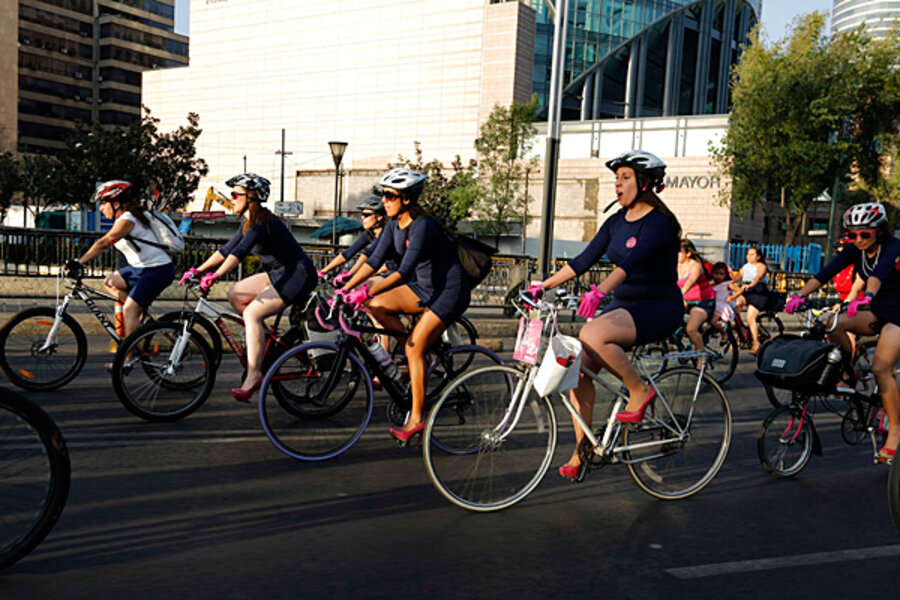Today, we ride: Women join Mexico City's cycling revolution
| Mexico City
Scores of bikers pedal by the Parque España in Mexico City each weekday morning, sporting suits, wearing backpacks, and in some cases balancing a mug of coffee in one hand.
Commuting by bike has become increasingly popular in the traffic-choked capital of 22 million since the creation of dedicated bike lanes starting in 2006 and a bike share program in 2010. Pay attention, however, and you'll see that the bikers are mostly men. Are women missing out?
A little more than 80 percent of Mexico City’s cyclists are male, according to a 2012 study by the Institute for Transportation and Development Policy (ITDP). But the number of women pedalers has started to slowly rise, increasing by 2 percent between 2010 and 2011. And peer-taught classes may have something to do with it.
Every Sunday, the city’s main thoroughfare, Reforma, is closed to vehicular traffic and taken over by bikers, runners, and rollerbladers. Laura Bustos Endoqui comes out each weekend for her volunteer “Sunday job” of teaching between one and three women to ride bikes. “I teach them balance, how to pedal, how to brake. It’s not about capability, but overcoming the fear,” Ms. Bustos says.
Some of Bustos’s students never learned to ride when they were kids; while others learned but haven’t tried for more than two decades.
“When they realize they can do this, there’s a change,” Bustos says. “When they are moving around the city on their own, they feel more independent.”
Few of the women learning through Bustos can put their finger on why they don’t know how to ride bikes. Melissa Ibañez, who met with Bustos for lessons two months ago and now helps teach, asks whether it might be social.
“In my family I’ve always felt supported, but society stereotypes women. That we’re weak, or fragile,” she says. “But I knew that if I could do this, I could make other goals happen in my life. It’s an indescribable power.”
A new city
Bustos taught herself how to ride about five years ago at the behest of cyclist friends.
“When I got on a bike, it changed my entire perception of the city,” she says. She felt more engaged with the people around her, making eye contact with street vendors and pedestrians. That eventually translated into feeling more secure as a woman in what she describes as a “slightly unsafe” megacity.
She uses her bike to go everywhere – rain or shine, day or night – and finds it more comfortable than the often “suffocating” experience of crowded public transport. She recently started working with the city’s bike-share program, called Ecobici, and when she picks up her phone, a sticker on the back reads “BIKE.”
Biking has exploded in parts of Mexico City. Ecobici has installed 275 stations across different neighborhoods, with about 4,000 bikes in circulation, and plans to bring stations into even more areas. The cost of membership is relatively affordable, with an annual subscription coming out to 400 pesos a year, or $35. There are more than 70,000 people signed up for the program in Mexico City today, according to Ecobici, and the majority of riders are between 20 and 40 years old.
Move yourself
On a recent Sunday afternoon three students join Bustos for lessons, and each is in a different stage of the learning process. One woman practices how to brake, one works on her balance by sitting on the seat and taking baby steps to propel herself forward, and another tracks back and forth, with Ms. Ibañez running beside her holding onto the rear of the bike.
Ibañez munches on a lollipop as she ticks off the reasons she’s taken to biking, just two months after learning how: She’s saving time and money on public transportation, she’s seen changes in her body from the exercise, and she feels a new sense of freedom.
So far, Bustos has taught around 40 women to ride, and she recently launched a crowd-funding project called Muévase Usted Misma, or “Move Yourself,” to expand her reach. The more bikes she has to loan out, she says, the more women she can turn on to bike commuting.
'Untrammeled womanhood'
At the end of the afternoon on Sunday, first-time rider Yamanic zips over to Bustos, showing off her new braking skills (right brake before left, and not too hard, she explains.)
“This was amazing,” she tells Bustos, stringing together five “thank yous” and smiling from ear to ear.
The idea that riding a bike might be empowering isn’t exactly new. Women suffragist Susan B. Anthony once said that the bicycle “has done more to emancipate women than anything else in the world.
“It gives a woman a feeling of freedom and self-reliance. The moment she takes her seat … away she goes, the picture of free, untrammeled womanhood.”






